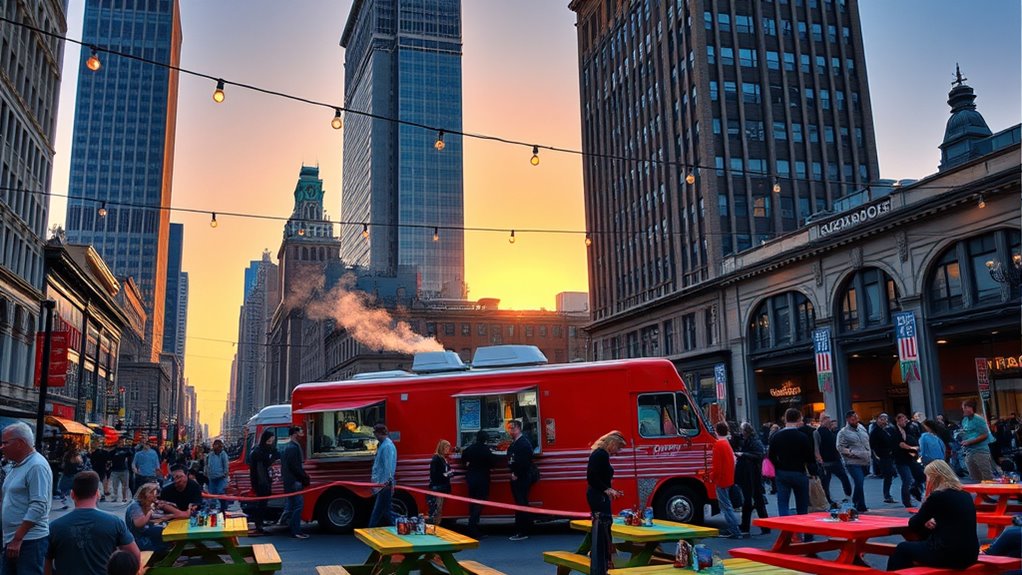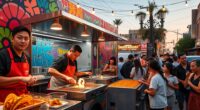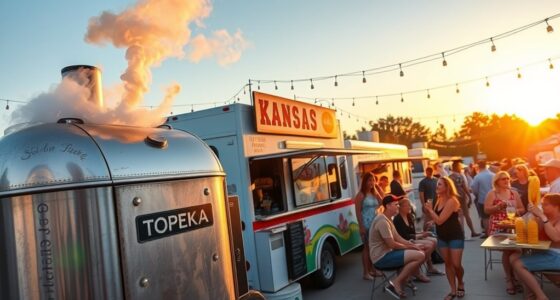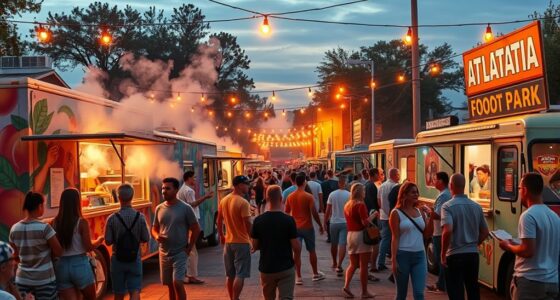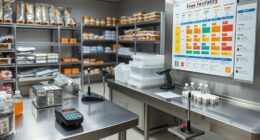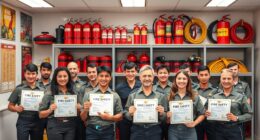To organize a food truck tour across cities, start by defining your goals and target audience to tailor your route and marketing efforts. Research city regulations and secure all necessary permits early. Plan your route efficiently, schedule visits around local events, and coordinate logistics for transportation and supplies. Promote each stop actively on social media and gather customer feedback. For detailed steps on each part, keep exploring to guarantee a smooth and successful tour.
Key Takeaways
- Research target cities’ demographics, local events, and food preferences to plan routes and maximize exposure.
- Obtain all necessary permits, health licenses, and parking approvals in advance to ensure regulatory compliance.
- Develop a detailed schedule aligning city visits with festivals, markets, or community gatherings for higher foot traffic.
- Coordinate logistics including route optimization, vehicle maintenance, and safety protocols for smooth transit.
- Engage customers through social media updates, local collaborations, and feedback collection to boost brand visibility and loyalty.
Defining Your Tour Goals and Target Audience
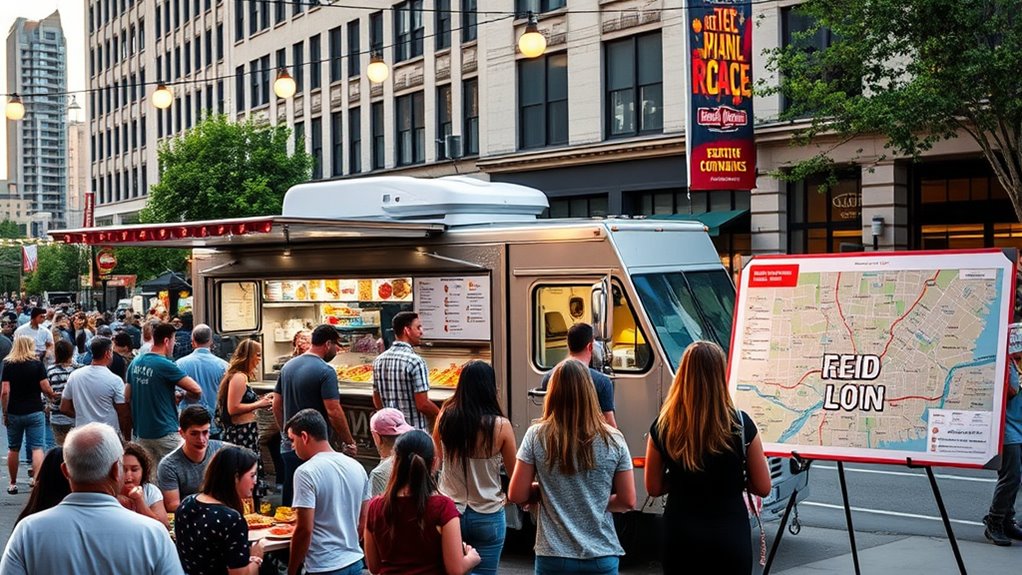
Have you clearly defined what you want to achieve with your food truck tour? Knowing your goals helps shape every decision, from branding consistency to marketing efforts. Are you aiming to boost brand recognition, launch new menu items, or build a loyal customer base? Clarifying these objectives guides your outreach strategies, especially through social media outreach, where you can target specific audiences and generate buzz. Consistent branding across all locations ensures your truck’s identity remains strong and recognizable, reinforcing your message with each stop. By setting clear goals, you can tailor your messaging, promotions, and engagement efforts. Incorporating brand recognition strategies can further enhance your tour’s success, making your food truck tour more successful and memorable for both you and your audience.
Selecting Cities and Planning Your Route
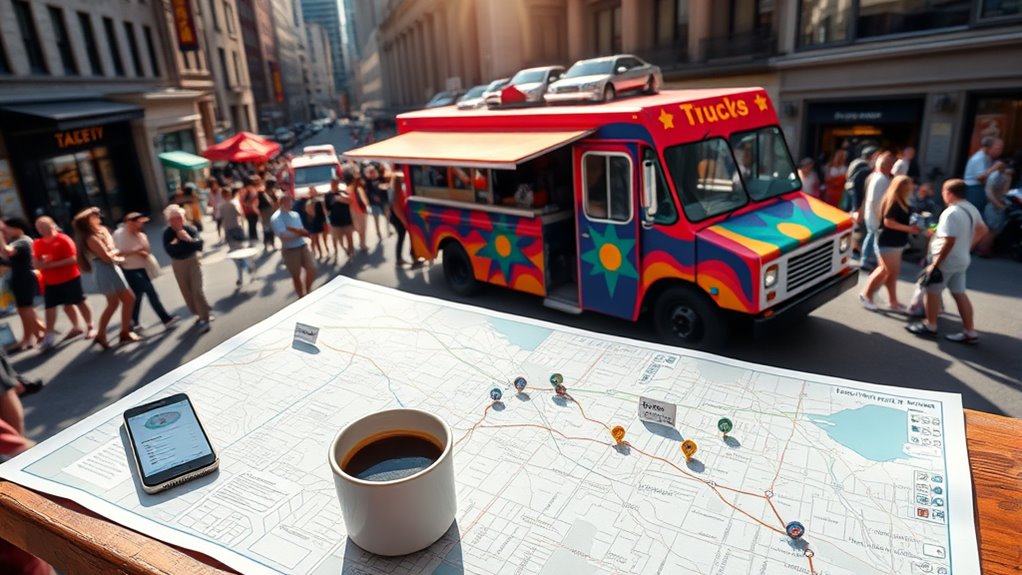
Choosing the right cities and planning an efficient route are crucial steps to guarantee your food truck tour’s success. Start by researching city demographics to understand your potential customers and their preferences. Focus on cities known for their vibrant local cuisine, as this attracts food lovers excited to try new flavors. Map out a route that minimizes travel time and maximizes your presence in high-traffic areas. Consider cultural events or festivals that draw crowds, aligning your stops accordingly. Keep logistics in mind—plan for rest stops, fuel, and potential overnight stays. By selecting cities that match your menu and targeting areas with strong foot traffic, you’ll create a route that boosts sales and builds your brand across diverse markets. Using strategic planning can help optimize your route for efficiency and success.
Securing Permits and Meeting Local Regulations
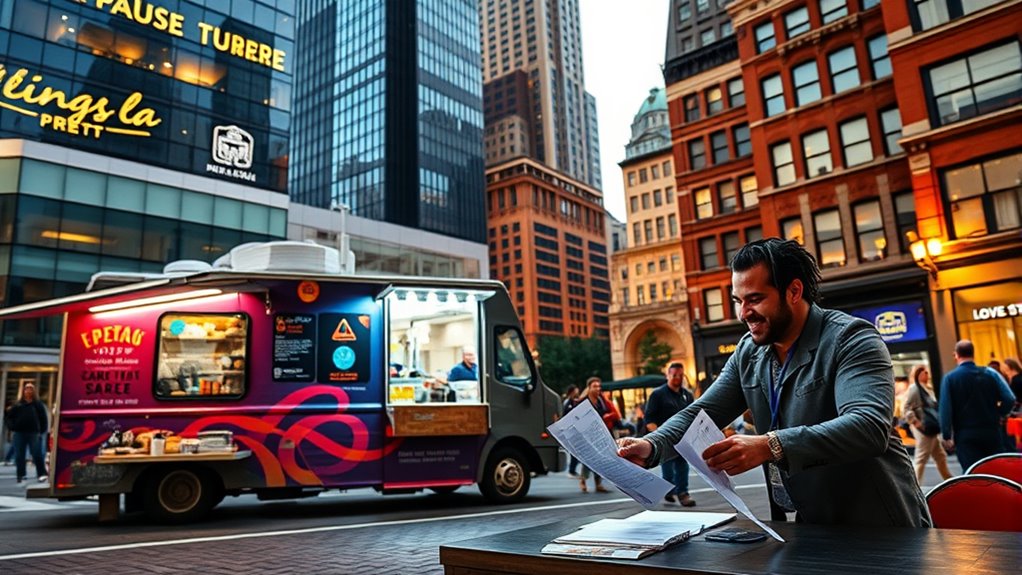
Securing permits and meeting local regulations is a critical step that can make or break your food truck tour. Without proper permissions, you risk fines or shutdowns, so start early. Research each city’s requirements for health permits, parking, and business licenses. Keep your food truck branding consistent and professional to satisfy inspections and attract attention. Use social media promotion to stay updated on local rules and share your compliance efforts, building trust with potential customers. Here’s a quick guide:
| Step | Key Focus | Tips |
|---|---|---|
| Research regulations | Permits & licenses | Check city websites and contact local authorities |
| Apply early | Paperwork deadlines | Avoid delays or penalties |
| Follow health codes | Food safety | Maintain cleanliness and document compliance |
| Coordinate with authorities | Parking & location | Secure spots in advance |
| Promote compliance | Branding & trust | Showcase your legal status online |
Additionally, understanding nutritional aspects of ingredients can help you meet health standards and appeal to health-conscious customers.
Scheduling Your Visits and Coordinating Dates
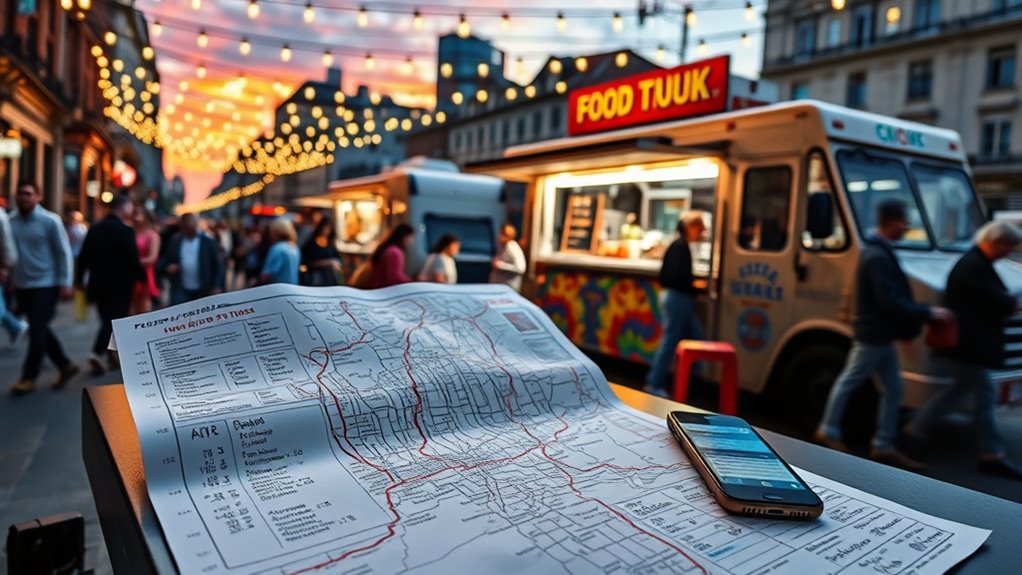
To make the most of your food truck tour, you need to map out a clear timeline for each city visit. Align your schedule with local events to maximize exposure and foot traffic. Planning ahead guarantees you stay organized and capitalize on busy times. Additionally, understanding the pinball culture in each city can provide unique opportunities for collaboration or themed events to attract more customers.
Mapping Out the Timeline
Creating a detailed schedule is essential for guaranteeing your food truck tour runs smoothly. To do this, leverage interactive maps to visualize your route and pinpoint ideal locations. This helps you plan visits efficiently and avoid unnecessary travel. Use your timeline to allocate specific dates for each city, considering local events or peak times. Good time management keeps your schedule realistic and flexible enough to handle unexpected delays. Keep track of important details like setup times, rest periods, and travel durations. Regularly updating your timeline ensures you stay on track. Additionally, understanding juice detox side effects can help you plan your breaks and manage your energy levels during the tour.
Aligning Local Events
Aligning your food truck visits with local events can considerably boost your visibility and sales. To do this effectively, establish strong local partnerships with event organizers and community groups. These partnerships can help you secure prime spots and gain access to targeted audiences. Coordinate your schedule to align with festivals, markets, or community gatherings, ensuring your truck is present when foot traffic is highest. Engaging with the community through these events not only increases sales but also builds brand recognition. Keep an eye on local calendars and reach out early to confirm your participation. Additionally, transparency in affiliate relationships can enhance your credibility when promoting local events or partnerships. By synchronizing your visits with key events, you demonstrate commitment to community engagement, which can lead to loyal customers and valuable word-of-mouth promotion.
Managing Logistics and Transportation

When managing logistics and transportation, you need to plan your routes carefully to maximize efficiency and save time. Implement safety measures to protect your truck and staff during transit, ensuring smooth travels between cities. By focusing on smart route strategies and safety, you keep your tour running seamlessly and avoid unnecessary setbacks. Additionally, reviewing legal information related to your operations can help ensure compliance and prevent legal issues during your tour.
Route Planning Strategies
Effective route planning is essential for ensuring your food truck operates smoothly across multiple cities. It helps you optimize your schedule, reduce travel time, and maximize sales. When planning, consider traffic patterns, local events, and popular spots to boost your food truck branding. Use social media promotion to announce your route and attract followers to specific locations. Map out your stops in advance to avoid last-minute surprises, and coordinate logistics like fuel stops and rest periods. Keep flexibility for spontaneous opportunities or adjustments. Additionally, track your progress and gather feedback to refine future routes. Incorporating predictive analytics can help forecast consumer behavior and identify the best locations to visit. By staying organized and strategic, you’ll enhance your tour’s success while maintaining a strong presence in each city. Proper route planning keeps your food truck running efficiently and your brand growing.
Transport Safety Measures
Managing logistics and transportation safely is crucial to keeping your food truck operational and preventing delays or accidents. Regular vehicle maintenance ensures your truck runs smoothly and reduces breakdown risks on the road. Schedule routine inspections for brakes, tires, lights, and fluids to catch issues early. Driver training is equally important; ensure your drivers are knowledgeable about safe driving practices, local traffic laws, and handling the truck in different conditions. Properly training your team minimizes accidents and enhances overall safety. Additionally, enforce safety protocols like securing loads and using safety equipment. Combining diligent vehicle maintenance with thorough driver training keeps your food truck fleet safe, reliable, and ready to serve across cities without unnecessary interruptions. Recognizing and addressing cheating behaviors within your team can foster a trustworthy environment and prevent internal issues that could compromise safety.
Marketing Your Tour and Engaging Customers
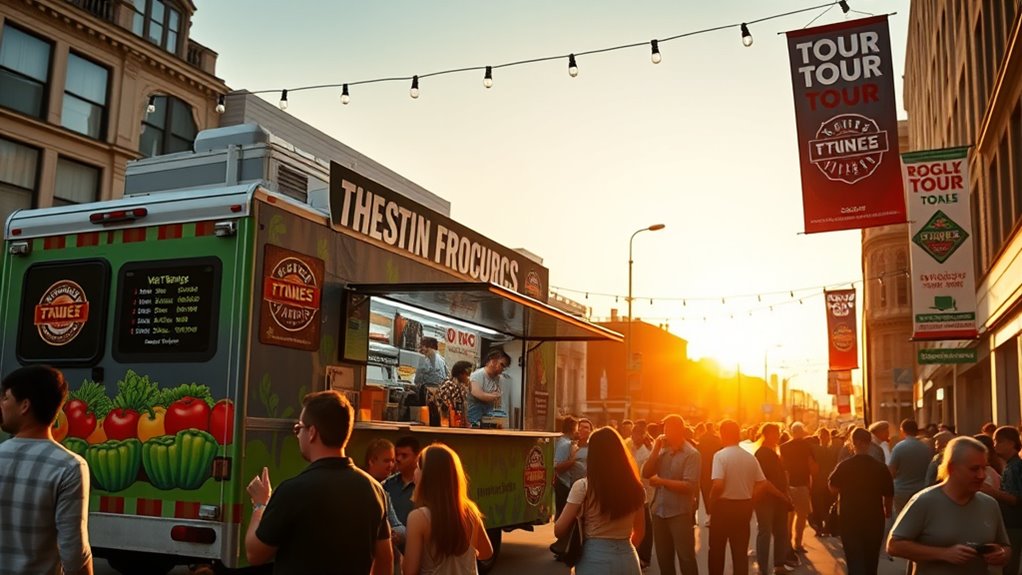
To successfully market your food truck tour and connect with customers, you need to craft a compelling brand message and utilize targeted promotional strategies. Focus on strong food truck branding that highlights what makes your truck unique. Use social media outreach to build excitement before and during your tour—share location updates, behind-the-scenes content, and special offers. Engage your audience with interactive posts and encourage followers to share their experiences. Consider collaborating with local influencers or community groups to widen your reach. Don’t forget to create eye-catching signage and flyers to attract attention in each city. By combining clear branding with strategic social media efforts, you’ll boost visibility and foster loyal customer connections throughout your tour. Additionally, leveraging targeted marketing techniques can significantly enhance your outreach and engagement efforts.
Preparing Your Menu and Stocking Supplies

Before hitting the road, you need to carefully plan your menu and stock supplies to guarantee smooth operations across all cities. Focus on menu customization to appeal to diverse tastes while keeping it manageable for quick service. Prioritize versatile ingredients that can be used in multiple dishes to streamline inventory management. Track your stock levels regularly to prevent shortages or excess, adjusting orders based on demand and sales patterns. Consider local preferences or regional specialties to tailor your menu without overcomplicating your inventory. Organizing your supplies efficiently to ensure everything is ready for each stop is crucial. Effective inventory management can help you avoid unnecessary delays and keep your food truck running smoothly, serving tasty options, and maintaining customer satisfaction.
Tracking Performance and Gathering Feedback
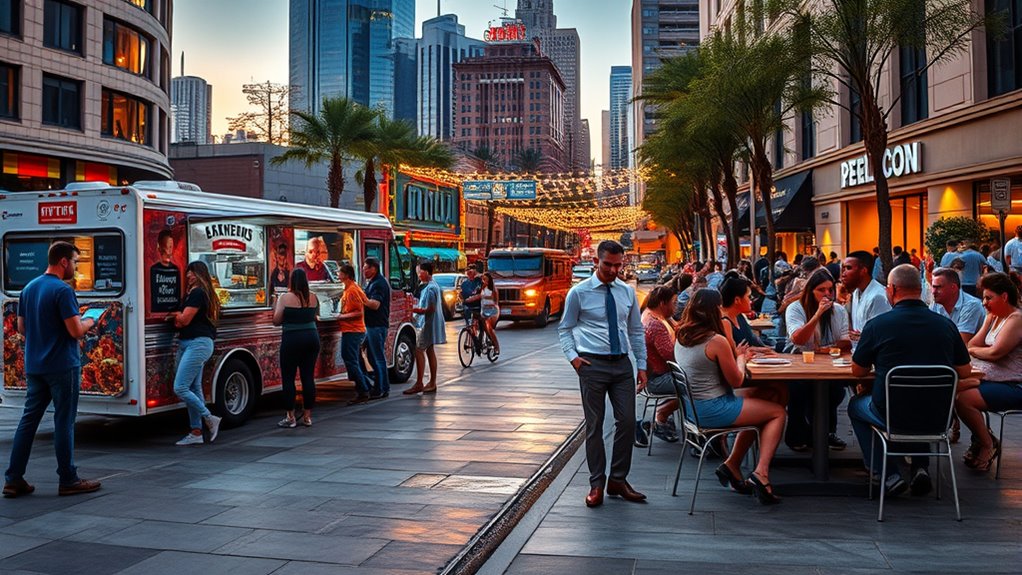
How can you guarantee your food truck stays on the right track? By regularly tracking performance and gathering feedback. Use digital analytics to monitor sales, popular menu items, and customer traffic patterns. This data helps identify what’s working and what needs adjustment. Additionally, customer surveys are invaluable for understanding customer satisfaction and preferences. Make it easy for customers to share their thoughts, whether through digital forms or quick feedback cards. To keep improving, consider these strategies:
- Analyze digital analytics reports for sales trends
- Conduct regular customer surveys post-visit
- Track social media engagement and reviews
- Adjust your offerings based on feedback and data insights
- Remember that attention in creative practice can also be applied to monitoring your business processes, ensuring consistent focus on improvement opportunities.
Frequently Asked Questions
How Do I Handle Unexpected Weather Disruptions During the Tour?
When unexpected weather disruptions hit, you should rely on your weather contingency plans to stay prepared. Quickly assess the situation and decide whether to move the trucks indoors or reschedule. Maintain clear emergency communication with your team and vendors, keeping everyone informed about changes. Being flexible and proactive helps minimize disruption, ensuring your tour continues smoothly despite the weather challenges.
What Are Effective Ways to Build Local Partnerships in Each City?
Did you know that 78% of successful events thrive on strong local partnerships? To build these, focus on community engagement by attending city events and connecting with local influencers. Seek out local sponsorships by offering mutually beneficial opportunities, like branding or exclusive vendor spots. Establish genuine relationships, support local causes, and demonstrate your commitment to the community. These strategies foster trust and create lasting partnerships that boost your tour’s success.
How Can I Manage Cash Flow and Budgeting Across Multiple Locations?
To manage cash flow and budgeting effectively, focus on profit management and expense tracking. You should regularly review your income and expenses at each location, adjusting your budget as needed. Use accounting software to keep accurate records, forecast cash flow, and identify areas where you can cut costs. Staying on top of these financial aspects guarantees your tour remains profitable and financially sustainable across all cities.
What Safety Protocols Should I Implement for Staff and Customers?
You should prioritize food safety by implementing strict hygiene standards and regularly sanitizing surfaces. Train your staff thoroughly on proper food handling, cross-contamination prevention, and customer interaction protocols. Make certain all staff wear appropriate protective gear and follow health guidelines. For customer safety, maintain clear signage about safety measures, enforce social distancing where needed, and monitor for any health concerns. Consistent staff training and adherence to food safety practices keep everyone safe and confident.
How Do I Handle Negative Reviews or Customer Complaints on Tour?
When handling negative reviews or customer complaints, prioritize customer engagement by responding promptly and professionally. Use review response strategies that acknowledge their concerns, apologize sincerely, and offer solutions or compensation if appropriate. Show empathy and thank customers for their feedback, demonstrating you value their experience. This approach not only resolves issues but also builds trust and encourages positive interactions, turning negative feedback into opportunities for improvement and stronger relationships.
Conclusion
With careful planning, your food truck tour can be a well-oiled machine that leaves a trail of satisfied customers and memorable experiences. Think of it as orchestrating a symphony where every detail, from permits to menu choices, plays a essential note. Stay flexible, adapt to each city’s rhythm, and keep your passion fueling the journey. Before you know it, your tour will be a story worth sharing—a feast for both the palate and the soul.
